“Even the smallest feline is a masterpiece of nature” – Leonardo da Vinci
When most people hear the words ‘Renaissance cats’, they imagine portraits of their pets decked out in Renaissance regalia. This is not what this guide is about. Here, I’m talking about felines, from lions to domestic cats, captured in Florentine Renaissance art.
If you’ve been following The Wildlife Diaries, you will know that I mostly travel in search of encounters with wild cats in wild places. Of course, for my trip to Florence, I wasn’t thinking about cats. I was interested in Renaissance art.
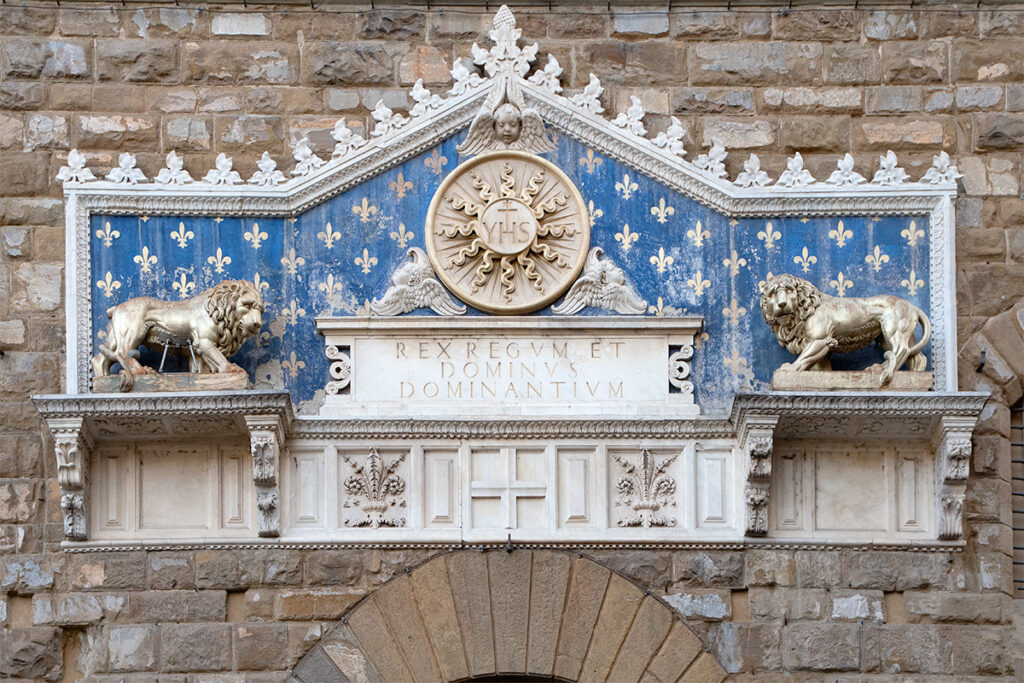
Yet cats I found. It appears that the Renaissance masters from Donatello and Da Vinci to Vasari and Salviati were as passionate about felines as I am. There are countless images of lions, leopards, cheetahs, and domestic cats to be discovered in some of Florence’s most iconic sights.
So, if you consider yourself a cat person, appreciate Renaissance art, and have about 3 days in Florence, this guide to the Renaissance cats of Florence is for you.
The Marzocco
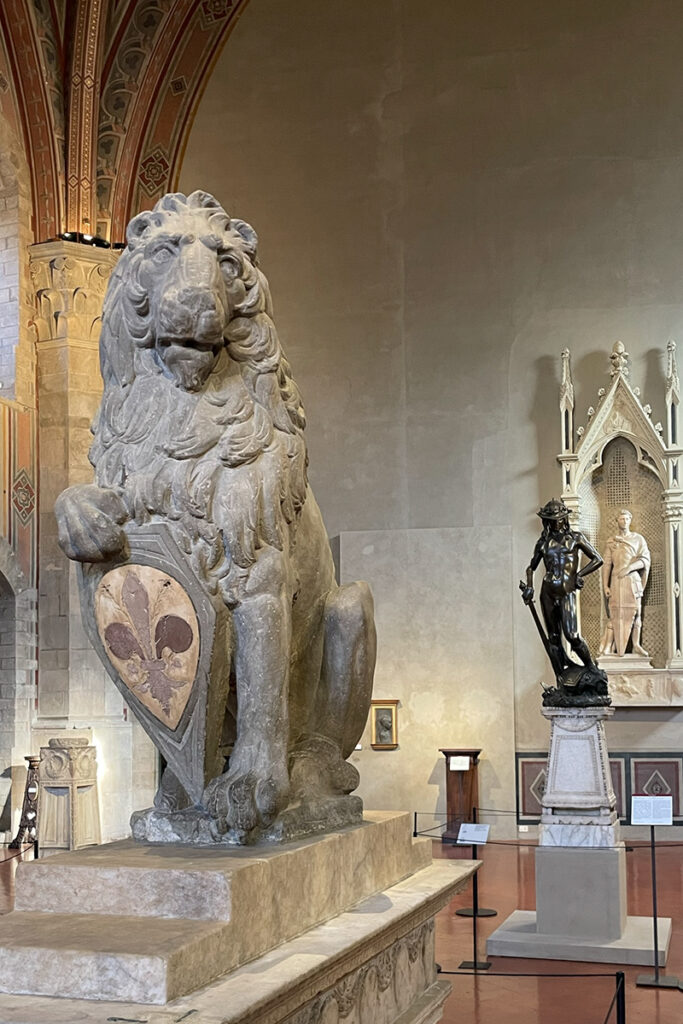
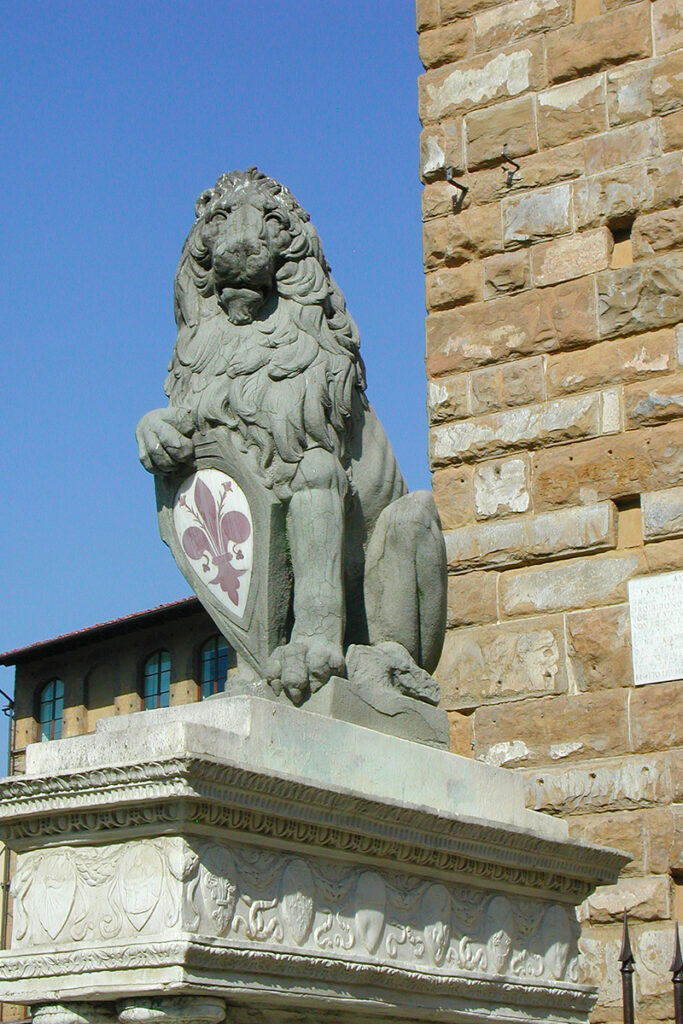
Florence has a deep connection to felines. The city’s heraldic symbol is a lion, known as the Marzocco. You see marble lions all over Florence, but only those that hold the Florentine Lily (Giglio of Florence) are technically the Marzocco.
The first piece of public secular sculpture commissioned in Florence (in the late 14th century) was a sculpture of the Marzocco that stood at the front of the Town Hall (Palazzo Vecchio) in Piazza Della Signoria.
The original sculpture didn’t last and was replaced in 1420 by Donatello’s famous Marzocco. Later, Donatello’s sculpture was replaced by a copy, and the original was moved to the Bargello Museum, where he joined the ranks of several other representations of Florentine lions on the exhibit.
Leopards of the Maggi Chapel
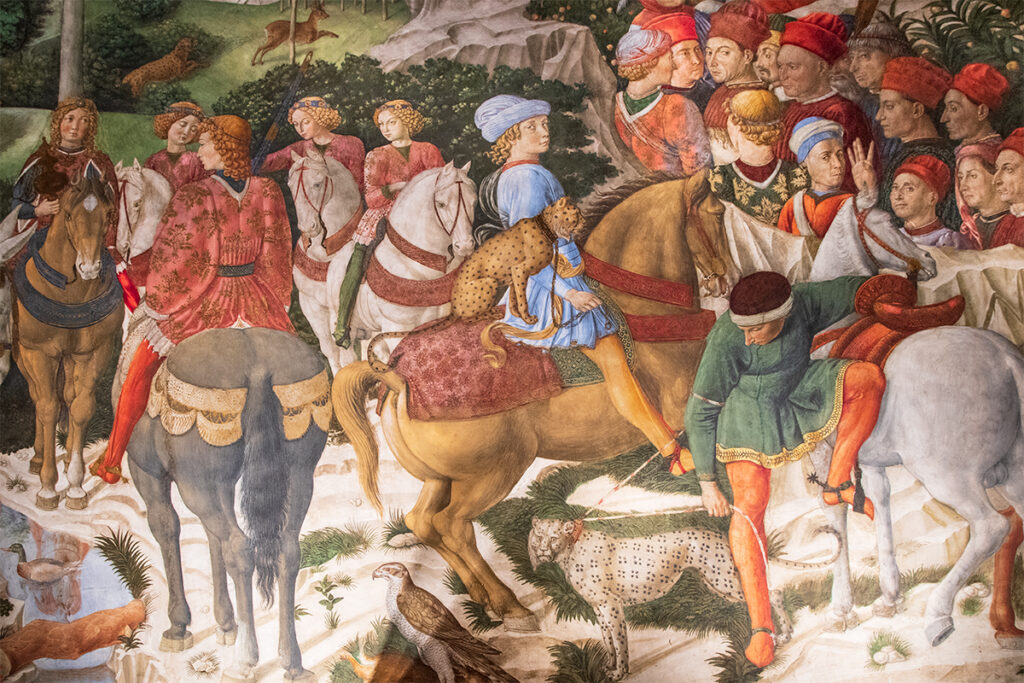
The most cat-rich work of art in Florence is Benizzo Gozzoli’s stunning frescoes in the Chapel of the Maggi in the Medici family’s first palace in Florence – Palazzo Medici-Ricardi. A single scene in this spectacular fresco contains 3 (!!!) Renaissance cats.
The chapel is one of the most exquisite hidden gems in Florence, its walls entirely covered by a series of frescoes painted around 1459 on commission from Cosimo’s son – Piero de Medici.
Spotting all three cats takes a bit of effort, which makes them all the more surprising. One is sitting on the back of a horse, another is standing on the ground right below it. Art historians refer to the cats on this fresco as leopards, but Gozzoli went to the effort of painting the two cats differently.
They clearly have different spot patterns, and these patterns are the easiest way to tell the spotted cats apart. So, while the cat standing on the ground has the body shape of a cheetah, its open rosettes suggest that it is a leopard. And the cat on the horse’s back must be a cheetah since it has solid spots.
Both cats, however, have tear marks – the black lines running from the eye down the cheek – which are a trademark of the cheetah. It is quite likely that Gozzoli hasn’t seen these cats live and used some creative licence in his representations.
The third spotted cat is chasing after a deer in the forest in the background.
Lion Street of Florence
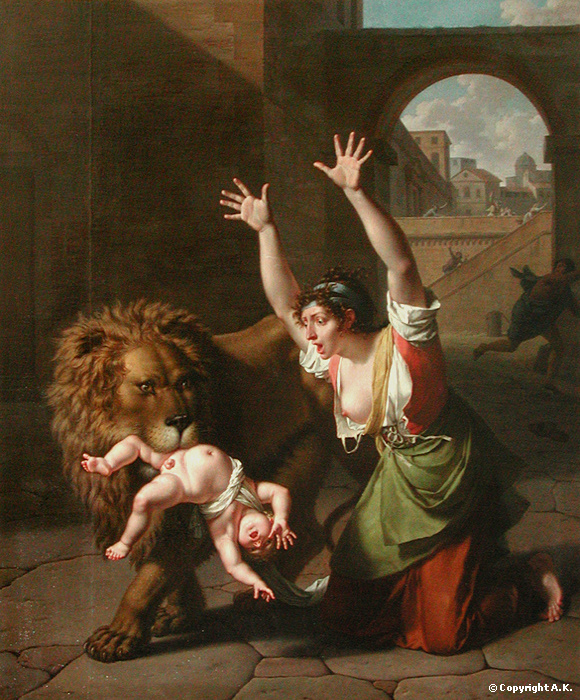
Piazza della Signoria seemed to have a particularly strong association with lions. The Florentines were so enamoured with the lion that they kept several living, breathing lions housed in cages since the 13th century. In Renaissance times, caged lions were kept on the street behind Palazzo Vecchio. This street is still called Via dei Leoni (Lion Street).
Florentine lions were quite famous in their time, and there are some historical records of their presence. One recounts a story of a boy called Orlanduccio. One day, sometime in the second half of the 13th century, one of the lions escaped from his cage and ran into the streets of Florence. In the ensuing panic, the lion seized Orlanduccio. Seeing her child in the grip of a lion, Orlanduccio’s mother ran up to the lion and snatched her son back. The lion, it appears, didn’t mind, and both the child and the mother remained unscathed. After the incident, the boy became known as Orlanduccio of the Lion.
This story was well-known enough to inspire a French history painter, Nicolas-André Monsiau, to paint his Le Lion de Florence (The Lion of Florence).
Lions in Palazzo Vecchio
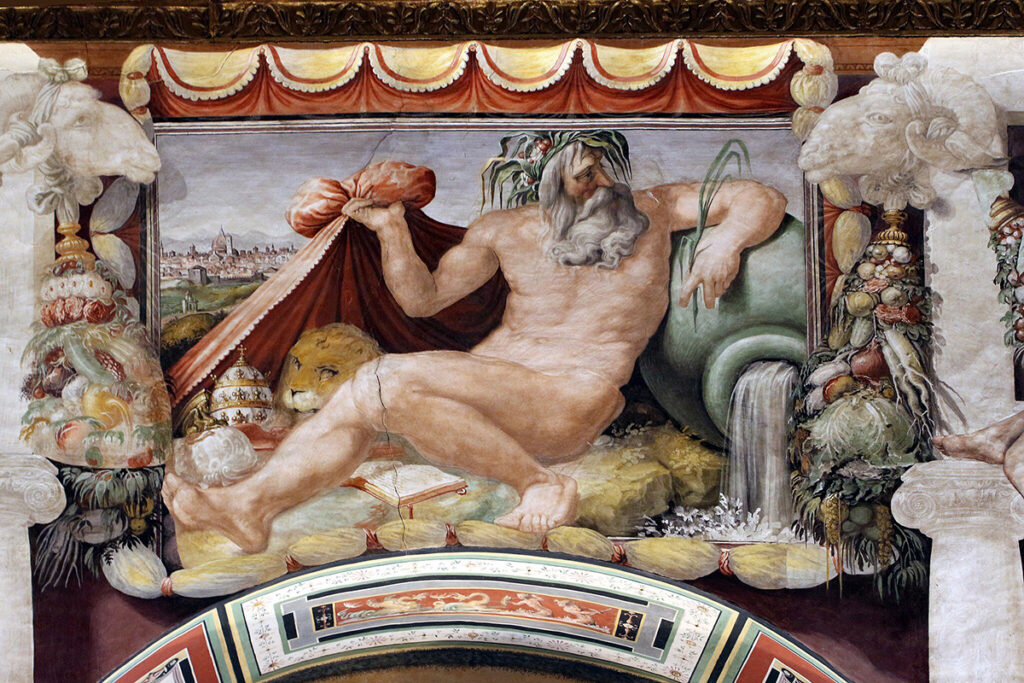
If you visit Palazzo Vecchio, and I highly recommend you do, you’ll find two marble lions in the second courtyard. Look up to the top of the palace’s Arnolfo tower, and you’ll spot another Marzocco topping the weather vane. This one is a copy, of course, and you can see the gilded copper original inside the palace.
The latest addition to Palazzo Vecchio’s feline menagerie is Francesco Vezzoli’s La Pietà in the third courtyard. The striking sculpture features a 20th-century lion rearing up on his hind legs and clutching a second-century BC Roman head in its massive jaws. The headless body is lying at its feet.
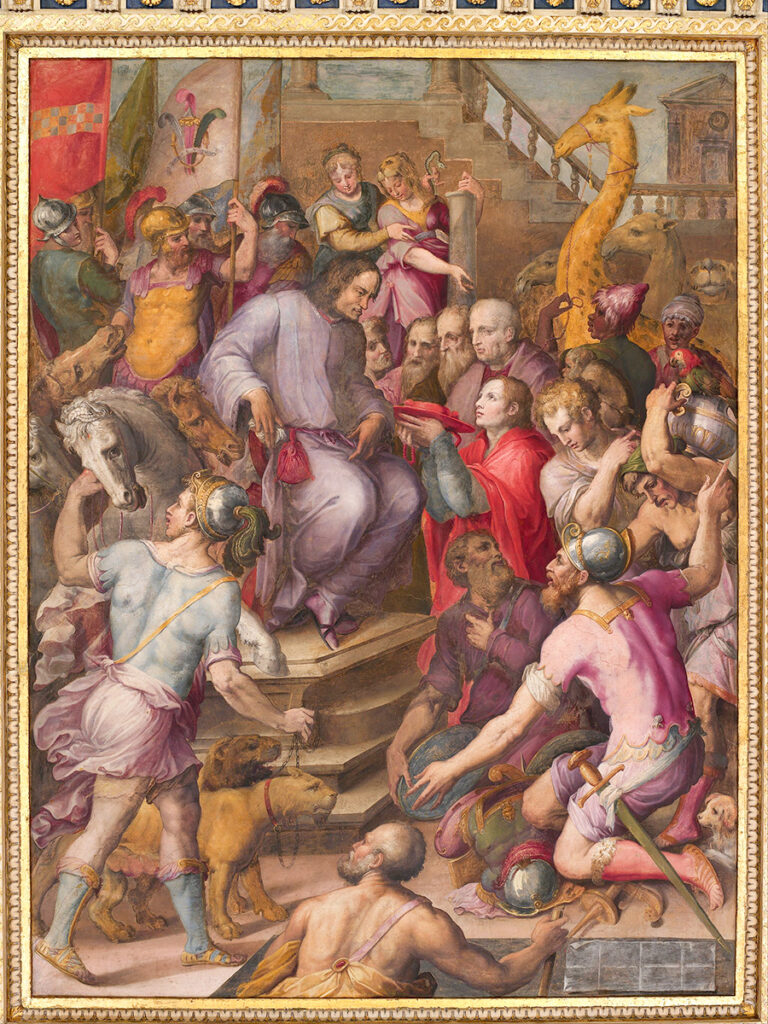
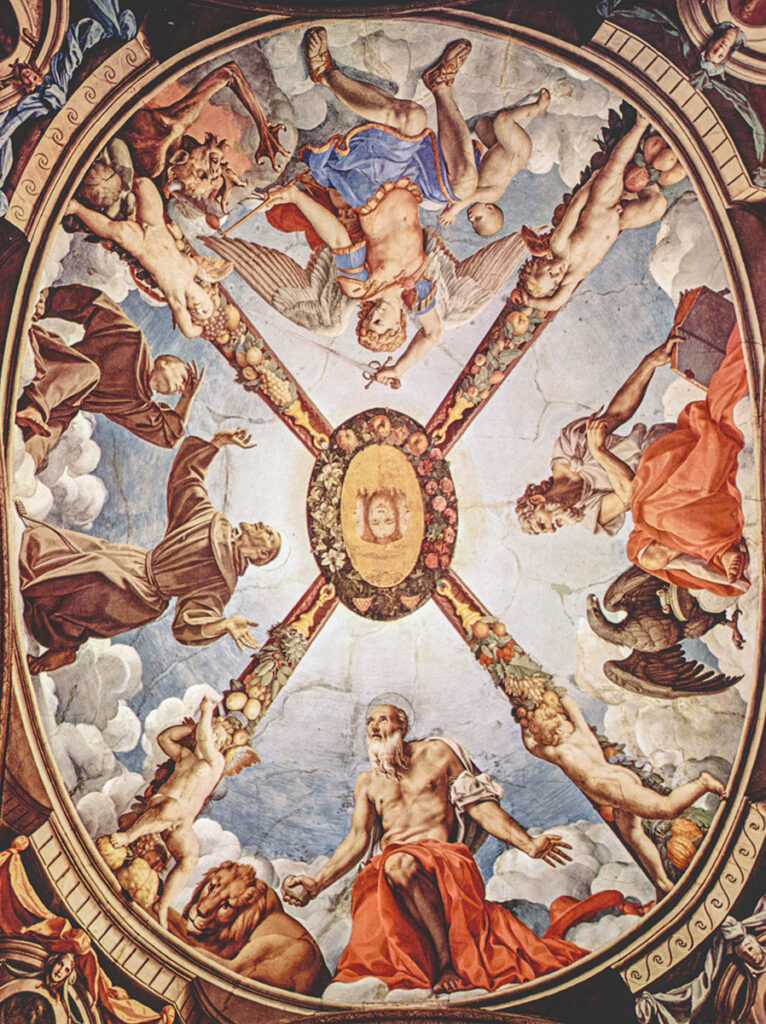
Visiting the interior of Palazzo Vecchio is like stepping inside the Renaissance painting, and there are plenty of lions and even a leopard in this landscape. The first lion you can spot is on Vasari’s extraordinary ceiling in the Hall of the Five Hundred.
Another lion is looking down on you from Francesco Salviati’s Allegory of the Arno River in the Audience Chamber. Another is lounging between a Saint and an angel in Bronzino’s spectacular frescoes on the ceiling of the Chapel of Eleonora.
But my favourite is Vasari’s fresco titled Lorenzo the Magnificent receives tribute of the Ambassadors. It is painted on the ceiling of the Lorenzo room in Leo X apartments. In addition to the two lionesses in the foreground, this fresco features a giraffe! That poor creature actually met untimely death by breaking its neck in the wooden beams of the enclosure built for him.
The Hall of Maps in Palazzo Vecchio is probably the most logical place to find Renaissance cats. The map of West Africa features both a lion and a leopard.
Renaissance Cats in Buontalenti Grotto
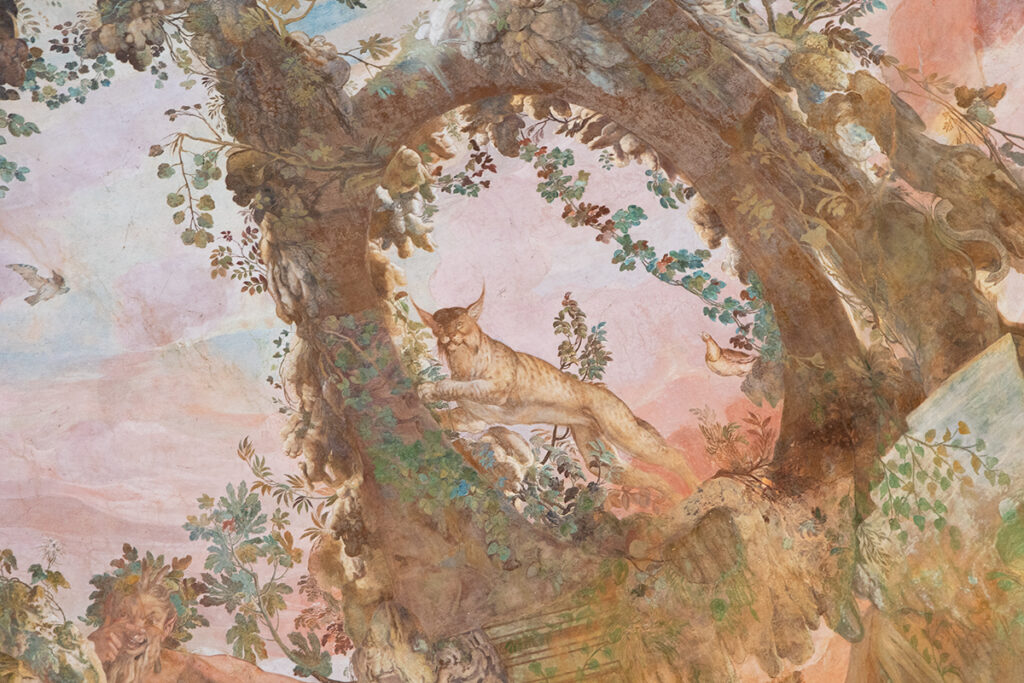
An exciting discovery was a new species of cat at Buontalenti Grotto. High up on the ceiling, above Michelangelo’s Prisoners, right above the mouth of the grotto, there is a beautiful rendition of a lynx by Bernardino Poccetti. You have to crane your neck to see it. The cat’s pointy ears and short tail are a dead giveaway.
Lynx should’ve been the most familiar cat to the Italian artists since, in their time, the species still roamed Italian forests. Sadly, it was probably easier to encounter a captive lion or maybe even a leopard in Renaissance Florence than a lynx in the Tuscan countryside.
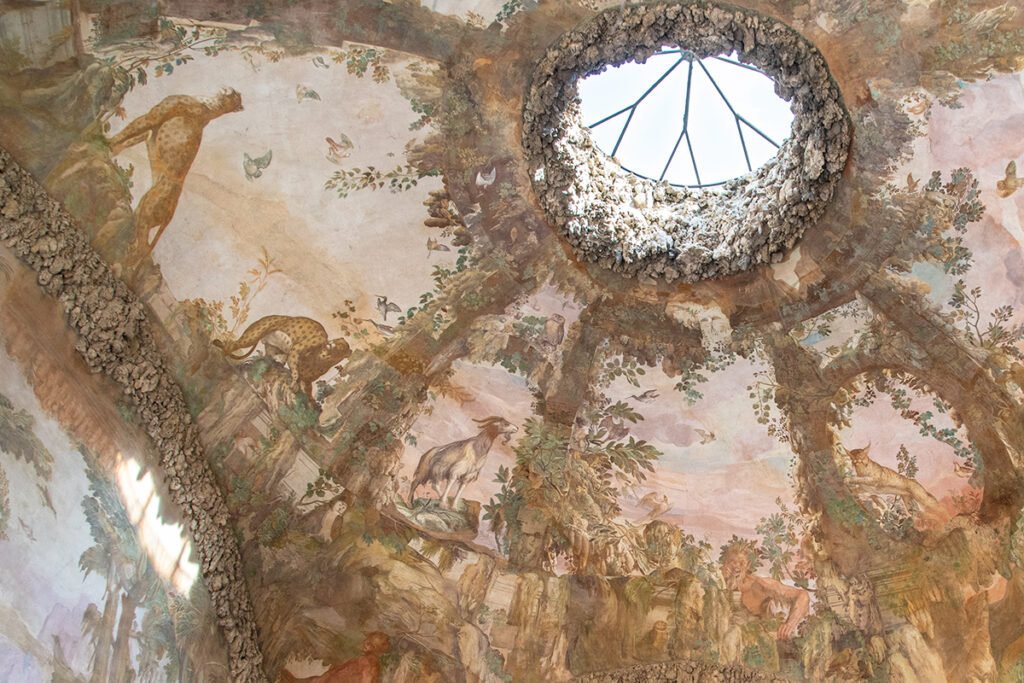
The lynx is not the only large cat on the grotto’s ceiling. There are two more cats with solid spots (rather than open rosettes), which suggests that Poccetti either pointed cheetahs or didn’t know the difference between cheetahs and leopards. In any case, this is the second site in Florence with three Renaissance cats in a single fresco!
Lions in Palazzo Pitti
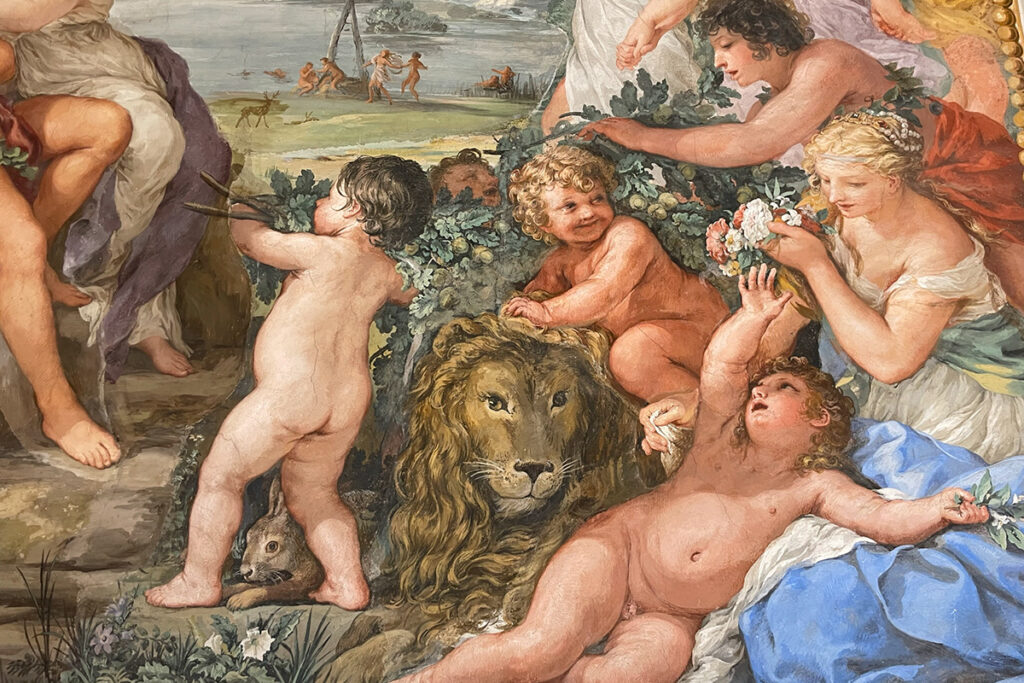
The third of the Medici Palaces in Florence, Palazzo Pitti is also not without its share of Renaissance cats. The most striking are the lions that pop up now and then on the ceiling of the Palatine Gallery. While not technically Renaissance, since they were painted between the 17th and 19th centuries, they were still painted in the classical style that distinguished the Renaissance.
Two of my favourites are The Golden Age by Pietro da Cortona and The Assembly of the Gods Presided over by Jupiter by Luigi Sabatelli.
Medici Lions
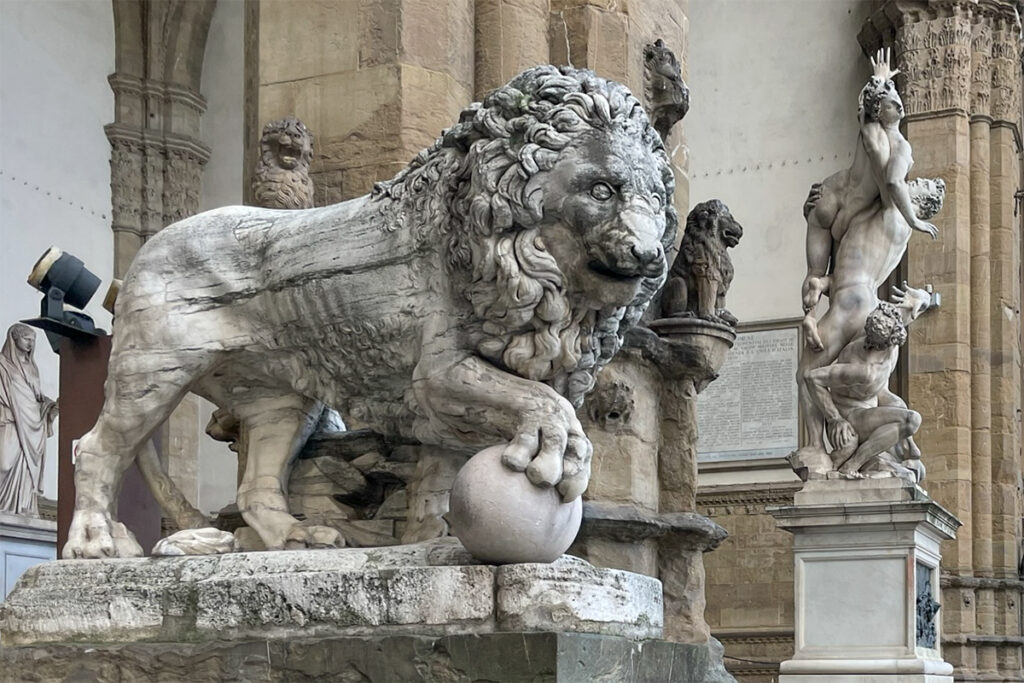
Two more lions in Piazza della Signoria guard the entrance to Loggia dei Lanzi – the spectacular open-air sculpture gallery. The two are a curious pair. The one on the right is 500 years older than the one on the left.
As the story goes, Fernandino I de Medici wanted a matching pair of lions for his villa in Rome. He already owned the 2nd-century Roman lion statue that was unearthed near San Lorenzo Gate in Rome. So, he commissioned Flaminio Vacca to carve a matching lion using a block of stone from the ruins of the Temple of Jupiter Optimus Maximus.
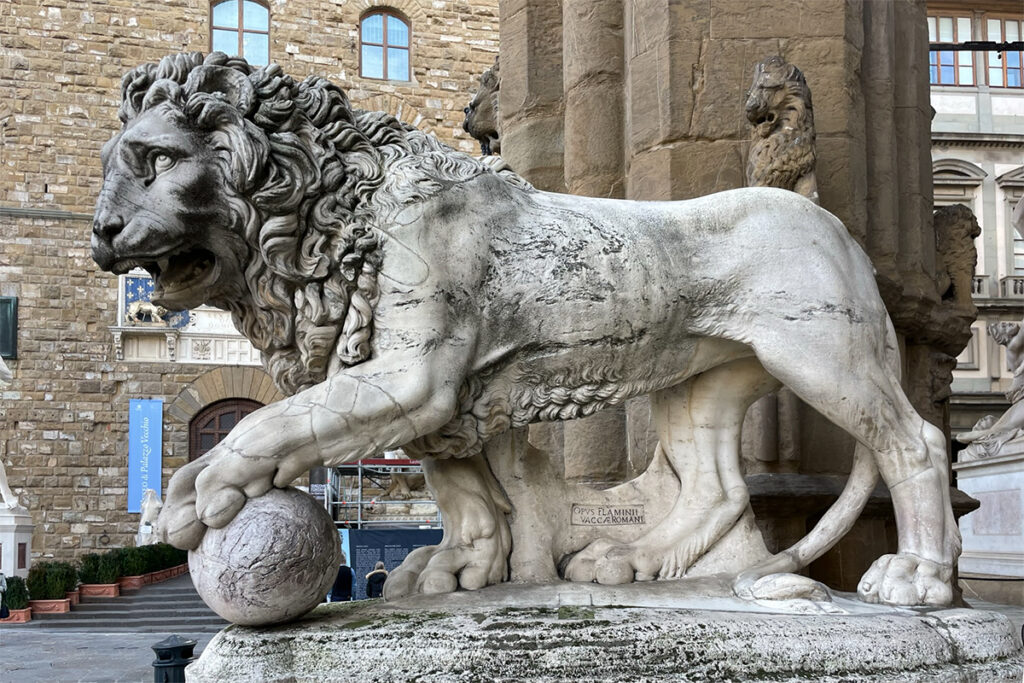
So, while the lion on the right is technically older, the one on the left has been caved from the stone of an Ancient Roman temple. Medici certainly knew how to party.
Both statues were brought to Florence in 1789 and installed in their current location.
Ghirlandaio’s Cat at The Last Supper
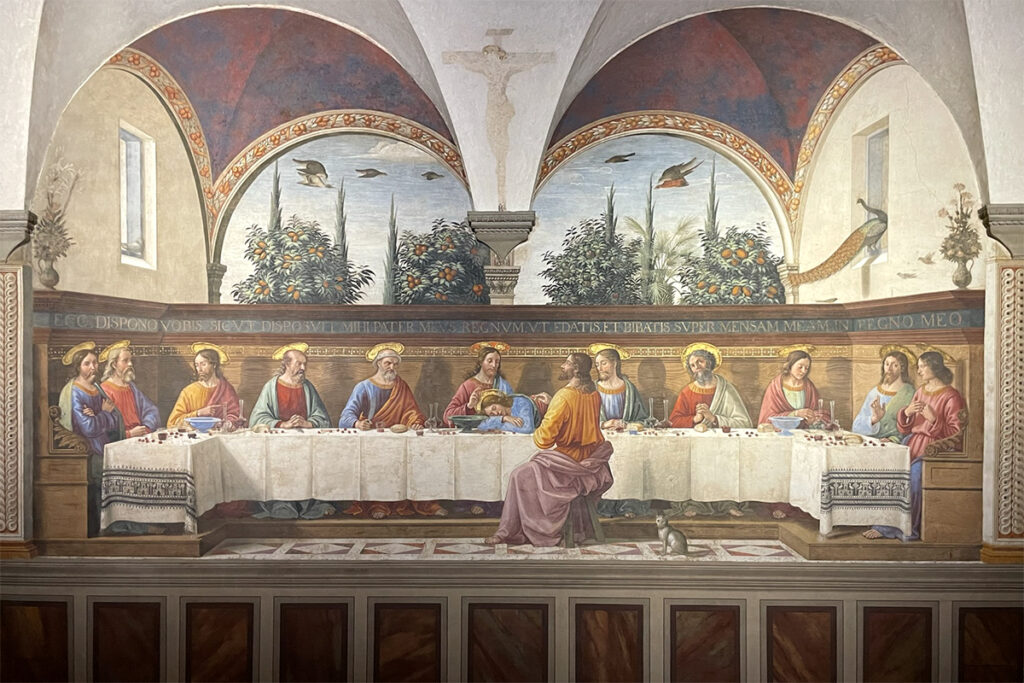
Ghirlandaio’s cat was the most surprising discovery for me. There are at least half a dozen versions of The Last Supper in Florence. They all follow the same theme – Jesus and his disciples gathered around a long table. Yet in his version of the painting in the San Marco convent, Ghirlandaio decided to invite a domestic cat to the supper.
The cat is sitting almost in the middle of the painting, but it is easy to miss because you know the painting and don’t expect to see anything dramatically different.
San Marco is a tranquil retreat from the buzz of Florence and is a somewhat off-the-beaten-path. But it seems like everyone who was anyone in Renaissance Florence has a connection to it, from Cosimo de Medici to Michelangelo to Savanarola.
Da Vinci Cats
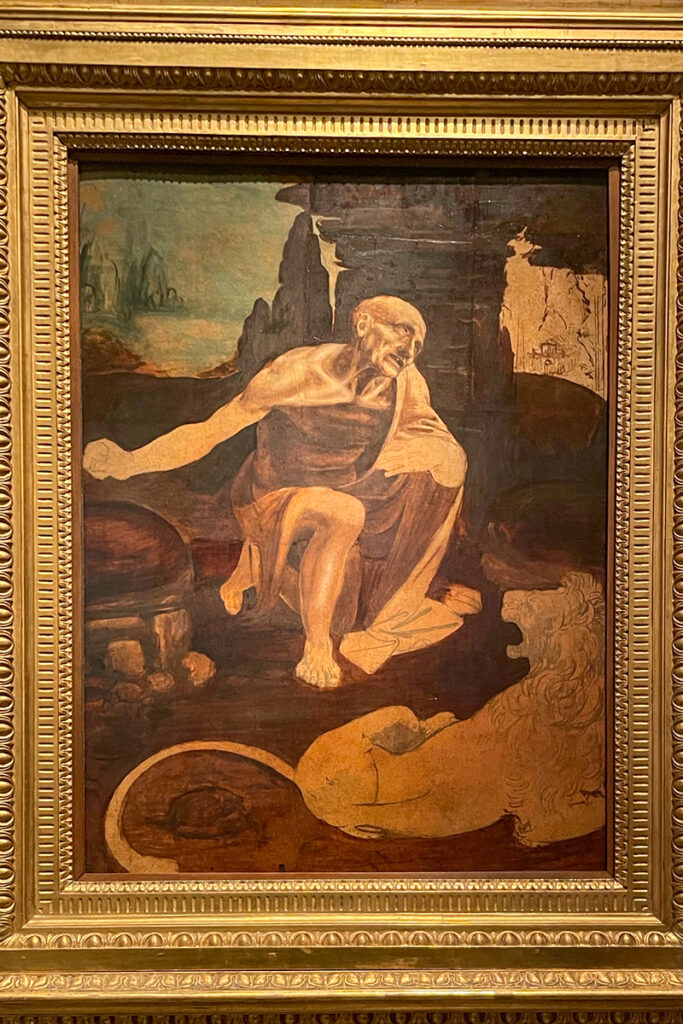
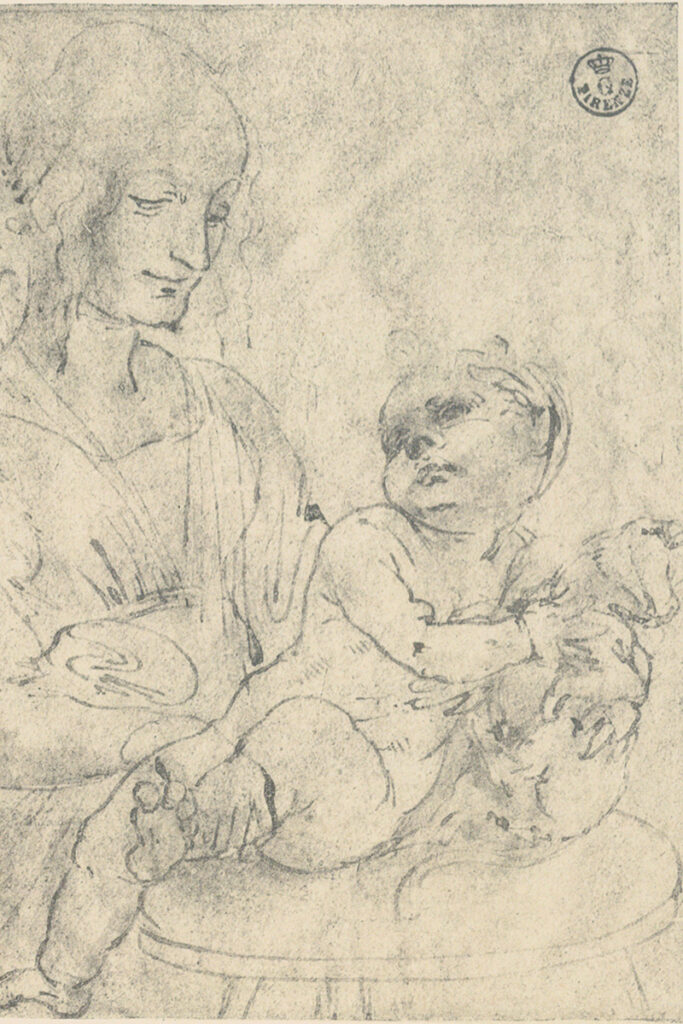
The most famous Florentine Renaissance man, Leonardo da Vinci, particularly appreciated the beauty of cats. He is believed to have proclaimed that “even the smallest feline is a masterpiece of nature”.
Leonardo particularly enjoyed sketching and painting lions and domestic cats. There is his unfinished painting of St Jerome in the Wilderness with a lion at the saint’s feet (kept in the Pinacoteca Gallery in the Vatican Museums in Rome) and his sketch of a Roaring Lion. The caged lions on Lion Street would’ve given Leonardo the perfect opportunity to observe and study their physique.
Da Vinci was equally fascinated by the domestic cat and sketched this feline on many occasions. His Study of Cat Movements and Positions sketch reveals his meticulous attention to the movements and autonomy of the domestic cat.
In Florence, you’ll find da Vinci’s cat on the first floor of the Uffizi Gallery in his sketch of the Virgin and Child.
Panthers at Uffizi Gallery
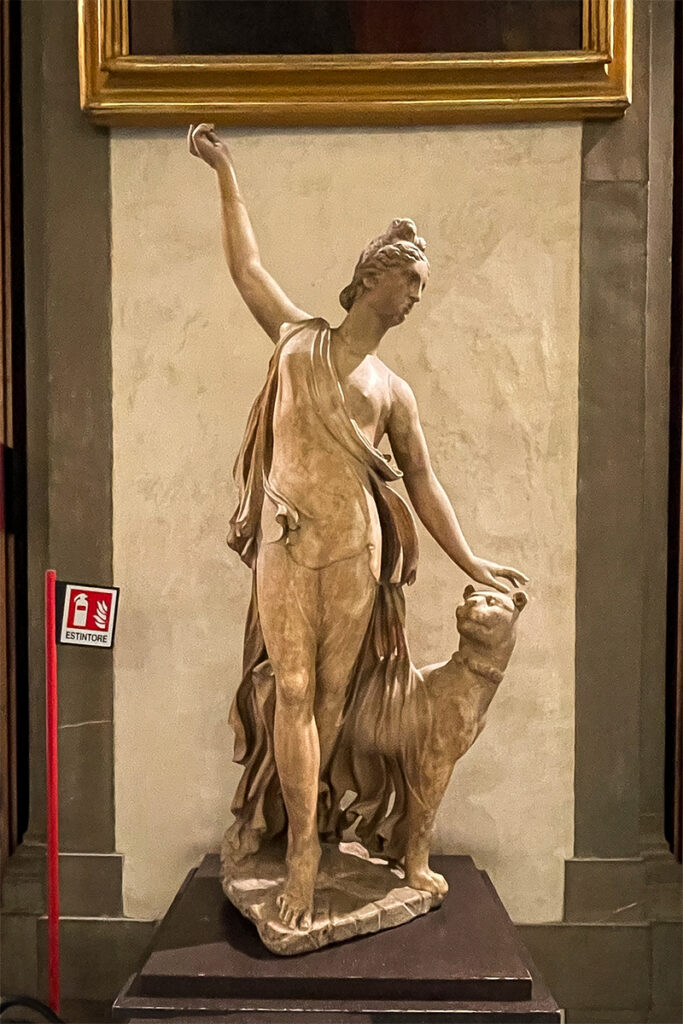
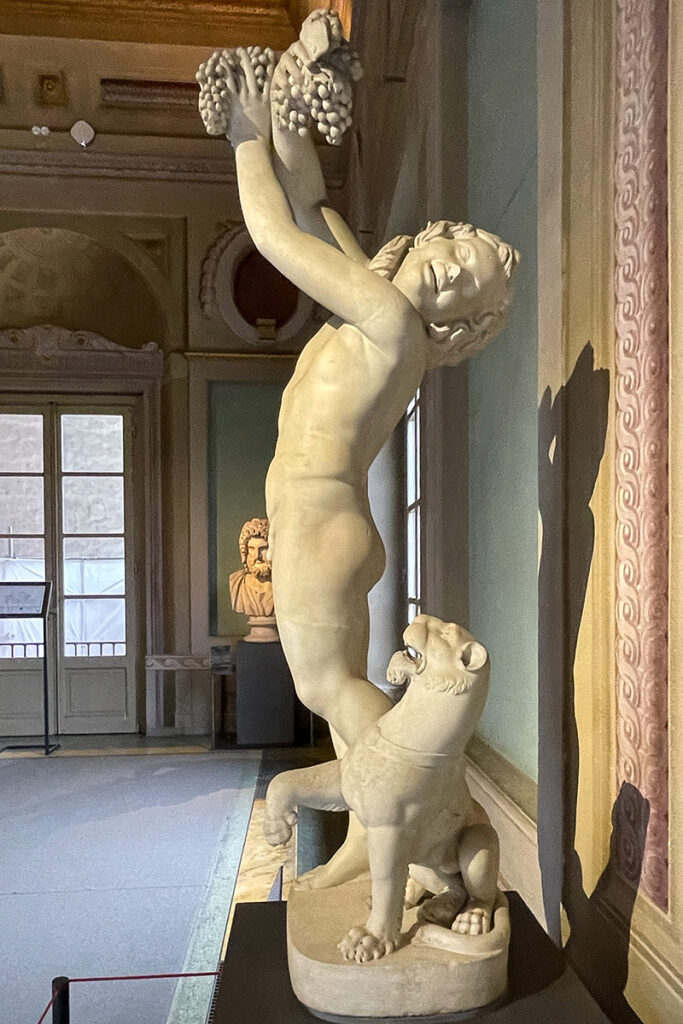
The Uffizi Gallery gets another honorary mention for several Roman statues that feature felines. While they were not created during the Renaissance, it was the classical art of Rome and Greece that inspired the Renaissance.
The most interesting sculpture for our purposes is that of a Nymph with a panther, thought to be the “Diana with a Serval”, which Giorgio Vasari (the world’s first art historian) saw in the Sala delle Nicchie in Palazzo Pitti. The addition of this serval brings the tally for wild cats in Florentine Renaissance art to 6 (!) species: lion, leopard, cheetah, serval, Eurasian lynx and domestic cat.
Cats on the Roof of the Duomo
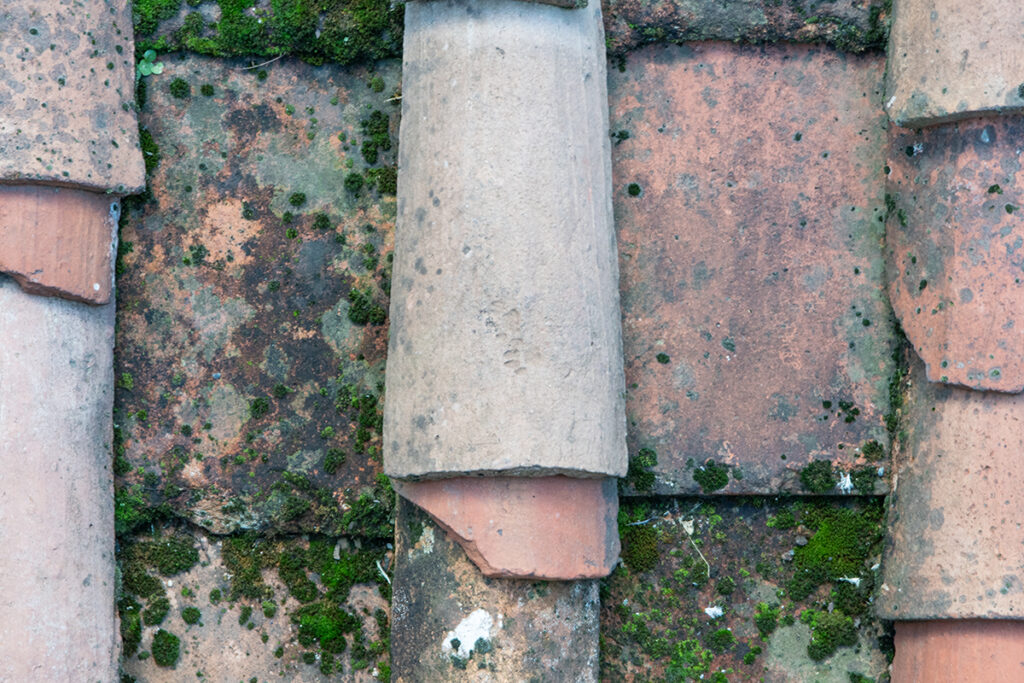
Here is a true hidden gem of Florence. On the roof tiles of Florence Cathedral, you can see a centuries-old cat paw print (right in the middle of the image above). This particular Renaissance cat is not a subject of art but rather its creator.
As Filippo Brunelleschi and his team worked on building the famous dome, Florentine cats, it appears, kept them company. In other words, cats have been walking all over our best efforts for centuries.
The only way to see this magnificent feline contribution to Renaissance art and architecture is by joining a tour that includes a visit to the Duomo roof terrace.
More on Exploring Italy
- Things to Do in Vinci Italy: Exploring Leonardo’s Adorable Hometown
- Rome in a Day: Best of Ancient Rome & the Renaissance
- 16 Things To Do in Assisi – A Walk Though a Medieval Hilltop Town
- 12 Charming Assisi Streets with Best Views & Medieval Vibes
- Uncover the Hidden Treasures of Roman Assisi, Umbria
- Quo Vadis – Assisi B&B Where Comfort Meets Medieval Charm
- 18 Weekend Breaks in Italy: Top Destinations to Visit and Things to Do
- Medici Florence – a Self-Guided Walk in the Cradle of the Renaissance
- Guide to Visiting Palazzo Vecchio: Must-see Art and Hidden Gems
- Leonardo da Vinci in Florence: In the Footsteps of the Renaissance Master

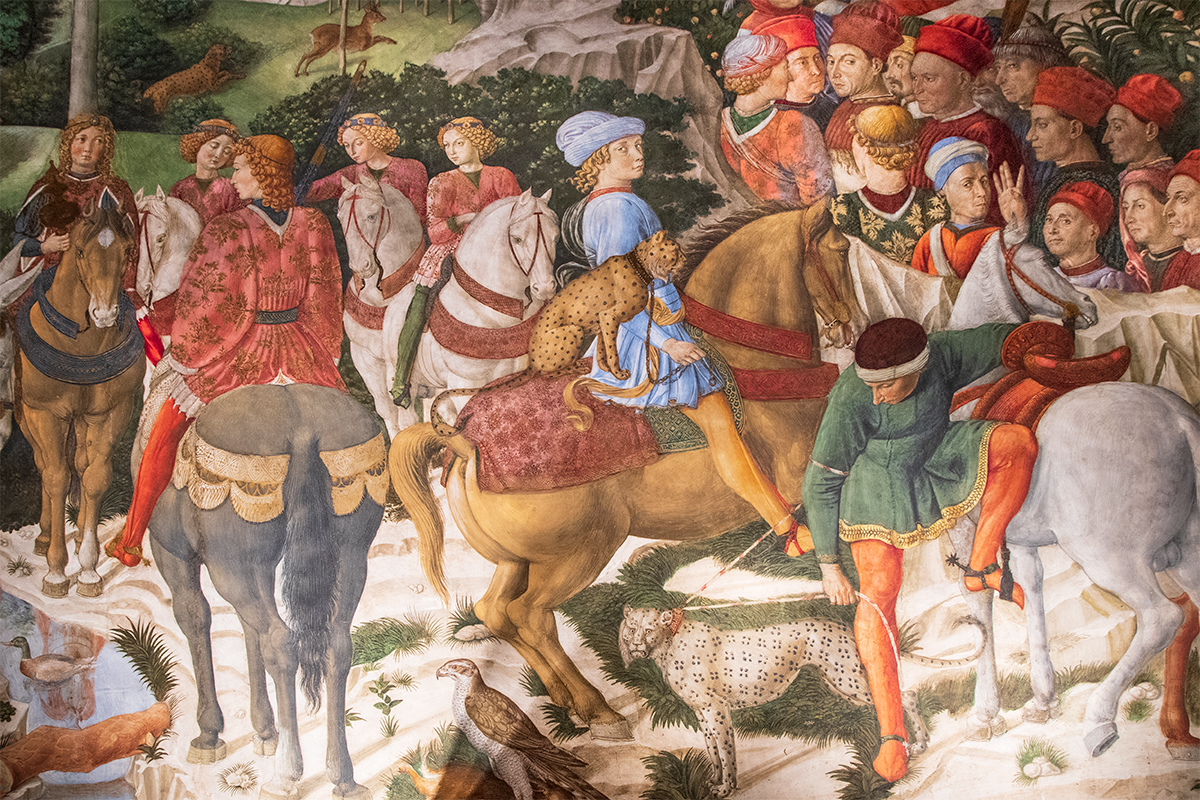
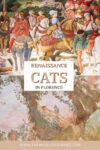

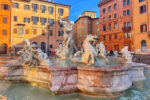
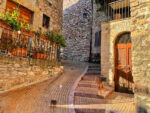
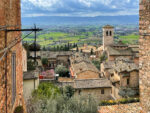
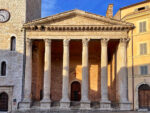
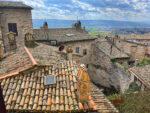
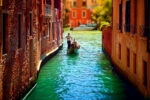
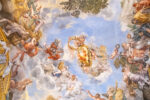

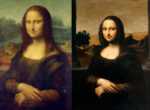
Ghirlandaio’s cat is a treasure!
I thought you would appreciate this particular kitty :)!